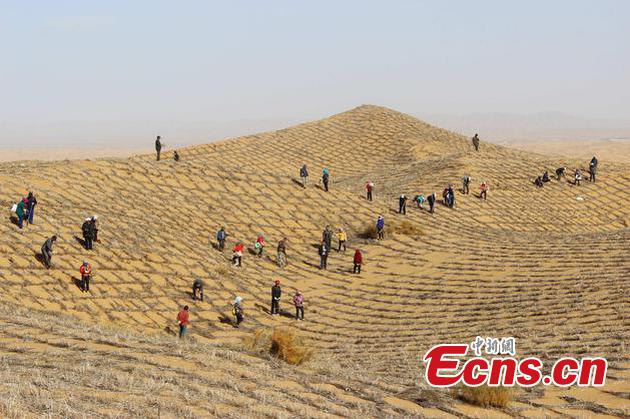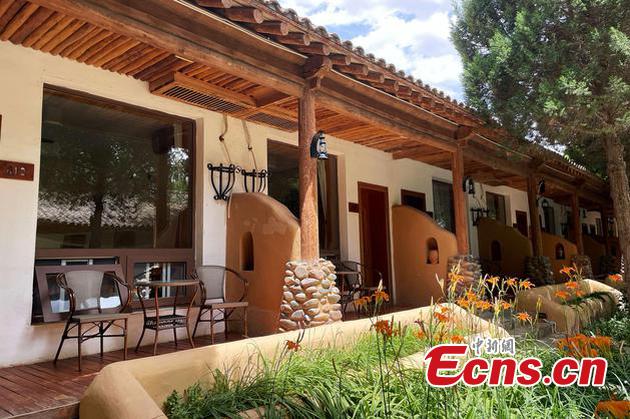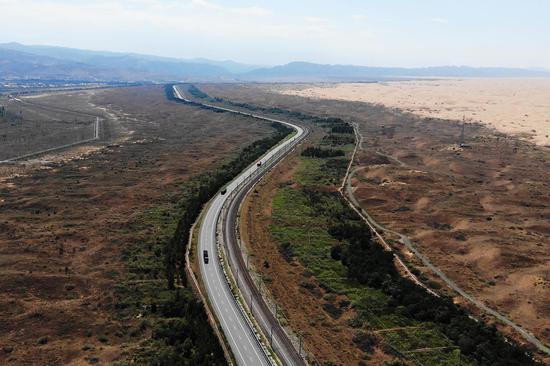Magic grid: the wisdom of China's sand control efforts
(ECNS) -- Checkerboards of green grass are thriving across the Tengger Desert of Zhongwei City, Ningxia Hui Autonomous Region, northwest China. Dubbed the "Magic Chinese grid," this checkerboard narrates the wisdom and miracle of China's sand control efforts.
Passengers on the Baotou-Lanzhou Railway train can experience the awe-inspiring crossings through the Tengger Desert within the territory of Zhongwei City. The lush green forest belts on both sides, and orderly wheat grids stretching into the depths of the desert, are a sight to behold.

Covering 66,400 square kilometers, Ningxia has over 10,000 square kilometers of desertified land. Surrounded by Mu Us Desert to the east, Tengger Desert to the west, and Ulan Buh Desert to the north, Ningxia is like a "peninsula" embedded in the sand.
With 181 towns in 16 counties threatened by the desert, the Shapotou, located on the southeast edge of Tengger, is one region historically affected by wind and sand disasters, hence its name.
In the 1950s, Shapotou was an obscure ferry on the Yellow River, with no more than 10 households or 100 villagers. That "the sand would pile up to the rooftops overnight," was a common saying among the elderly, who would daily sweep sand from their doorsteps during childhood.
Shapotou drew worldwide attention with the construction of China's first desert railway, the Baotou-Lanzhou Railway, in 1954.
Running from Baotou in Inner Mongolia Autonomous Region, to Lanzhou in Gansu Province, the 990-kilometer railway was built through the Tengger Desert for 140 kilometers.
As the railway was being built, the battle to prevent and control desertification began.
Foreign experts claimed that "desertification is a global challenge. Building a railway in the desert is unrealistic!"
However, the Shapotou Desert Research Station and Zhongwei Sand Fixation Forest Farm were officially established in Shapotou against all odds.
In the early stages of sand control, countless methods, including spreading pebbles, asphalt, or straw mats on the sand, were all destroyed by strong winds.
During a break, a sand control worker happened to insert a bundle of straw into the sand with a shovel. After a windstorm, all the herbaceous plants were swallowed by the yellow sand, but this bundle of straw stood firmly.
This gave sand control workers some inspiration. They tried similar measures and found a most effective way to stabilize sand.

After four generations of sand control exploration, Ningxia has developed a "five belts in one" windbreak and sand fixation system. This system has ensured the unobstructed running of the world's first desert railway, and led to a retreat of the desert by 20 kilometers.
In 1988, the sand control protection system of Shapotou Section of the Baotou-Lanzhou Railway was awarded the Special Prize for National Science and Technology Progress. In 1994, the Zhongwei sand fixation forest farm was listed as a "Global 500" site for environmental protection by the United Nations Environment Programme, promoted as a "miracle in the history of human sand control."
To this day, the low-cost, convenient, and environmentally friendly straw checkboard remains the "main role" in global sand control and has become the earliest such Chinese solution to be exported globally.
According to the sixth national monitoring of desertification and sandy land, the areas of desertified and sandy land in Ningxia have both decreased. Compared with the results of the fifth monitoring, these areas have decreased by 230.85 million mu (approximately 15,390 square kilometers) and 182.1 million mu (approximately 12,140 square kilometers), respectively.
About 20,000 local people have been able to settle here.
Today, Shapotou Scenic Area, known as "China's most beautiful desert" and "hometown of the stars", is welcoming tourists.

Visitors can not only enjoy cozy homestays, but also a five-star standard desert hotel and a desert-themed vacation center, said Zhang Yupu, governor of Ningxia.
When night falls, visitors can experience sand therapy while gazing at the beautiful sky," he added.

